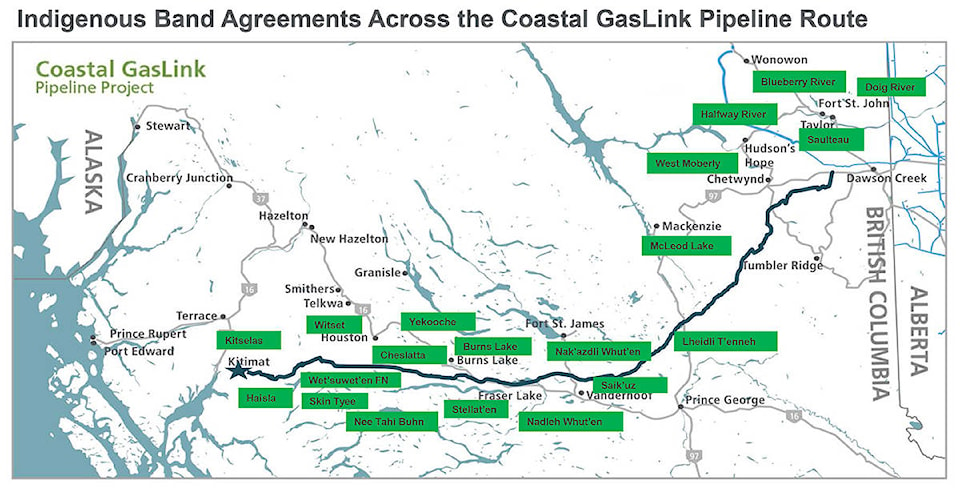The personal opinions of the Smithers resident who wants a federal review of the natural gas pipeline that would feed the pending LNG Canada liquefied natural gas plant at Kitimat are irrelevant, states his lawyer in a filing to the federal National Energy Board (NEB).
Instead, Michael Sawyer believes “it is constitutionally wrong that the [Coastal GasLink pipeline] project is not being regulated by the NEB,” indicates the filing.
Sawyer through his lawyer was responding to TransCanada’s own filing that the NEB reject his application that it consider whether it should review the project.
“The bulk of TransCanada’s submission consists of repetitious attacks on the integrity of Mr. Sawyer and the application. In reply, these allegations are not warranted and do not justify the board failing to examine whether the project is in federal jurisdiction.”
In its application, TransCanada said Sawyer’s objective was to “frustrate upstream natural gas development in B.C.,” calling his filing “vexatious and an abuse of process.”
Sawyer’s latest filing comes in the middle of heightened speculation that LNG Canada’s investors, which include Shell and Malaysian-government owned Petronas, are about to give the green light to the estimated $37 billion project to super cool natural gas for export via tanker to Asian customers.
And the prospect of a federal review has Kitimat and Terrace businesses and residents worried this would cause a delay or even cancellation of the project.
Sawyer’s on the record as saying the provincial environmental review of the pipeline and plant was inadequate.
And he’s said while natural gas may be a cleaner burning energy source than coal, that natural gas actually contribute more to carbon emissions when all aspects for natural gas from exploration to processing to eventual transport are considered.
Insofar as his application is concerned, Sawyer said TransCanada’s own statement indicate natural gas from an existing federally-regulated pipeline system would feed into Coastal GasLink thereby placing it under federal jurisdiction.
Sawyer bases his application on two previous court rulings, one of which was a result of a court action he undertook regarding another proposed northern natural gas pipeline that would have fed the now-cancelled Pacific NorthWest LNG project at Prince Rupert.
Just as is the case with Coastal GasLink, Sawyer argued that the Prince Rupert Gas Transmission pipeline should also come under federal jurisdiction and the Federal Court of Appeal referred his application back to the NEB to consider its merits.
The NEB has yet to decide how it will respond to Sawyer’s application.
Last week Premier John Horgan, speaking at the Union of B.C. Municipalities Convention in Whistler, said a final investment decision from LNG Canada was “now very, very close.”
LNG Canada itself says a decision will be made by the end of the year and energy sector analysts have been repeating that statement.
Plans for a construction camp in Kitimat to house up to 4,500 workers are advancing rapidly and dredging has started for a dock expansion in the Kitimat harbour.
Last week, TransCanada announced that all 20 First Nations along the Coastal GasLink route have signed benefit agreements (see page A9).
A decision on the new location for a workforce camp near Burns Lake is “pending very soon,” according to Kiel Giddens, spokesperson for Coastal GasLink.
Earlier this year the pipeline proponent abandoned its plans to build a camp at a proposed site near the shores of TchesinkutLake after public feedback revealed overwhelming opposition. Topping the list of concerns was the potential for water pollution and drainage issues, as well as increased traffic on Hwy. 35 between Burns Lake and Tchesinkut Lake.
“Coastal GasLink is still working through its decision process in consultation with the camp contractor, First Nations, and local governments,” said Giddens, adding that the wildfire situation in Burns Lake has caused meetings between TransCanada, the Village of Burns Lake and the Regional District of Bulkley-Nechako (RDBN) to be postponed.
Since Civeo Corporation announced a partnership with Stellat’en First Nation earlier this summer to supply a workforce camp in the Burns Lake area, TransCanada has been choosing a camp location that takes public feedback into account.
The possible locations include:
– Option one: located within the village, on the east side of the municipality near the area known as Industrial Park;
– Option two: located within the village beside Save On Foods;
– Option three: located within Electoral Area E of the RDBN on Hwy. 35;
– Option four: located within Electoral Area E of the RDBN on Crown Lands on Seven Mile Forest Service Road (FSR);
– Option five: located within Electoral Area B of the RDBN on un-surveyed Crown lands on Seven Mile FSR.
The next step is for Coastal GasLink to notify the RDBN, village and local First Nations of their decision.
